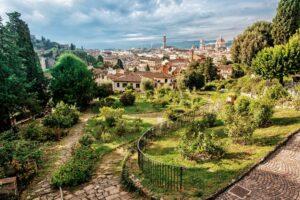Fodor's Expert Review Palazzo Vecchio
Florence's forbidding, fortress-like city hall was begun in 1299, presumably designed by Arnolfo di Cambio, and its massive bulk and towering campanile dominate Piazza della Signoria. It was built as a meeting place for the guildsmen governing the city at the time; today, it is still City Hall. The interior courtyard is a good deal less severe, having been remodeled by Michelozzo (1396–1472) in 1453; a copy of Verrocchio's bronze puttino (cherub), topping the central fountain, softens the space. (The original is upstairs.)
The main attraction is on the second floor: two adjoining rooms that supply one of the most startling contrasts in Florence. The first is the opulently vast Sala dei Cinquecento (Room of the Five Hundred), named for the 500-member Great Council, the people's assembly established after the death of Lorenzo the Magnificent, that met here. Giorgio Vasari and others decorated the room, around 1563–65, with gargantuan frescoes celebrating Florentine history;... READ MORE
Florence's forbidding, fortress-like city hall was begun in 1299, presumably designed by Arnolfo di Cambio, and its massive bulk and towering campanile dominate Piazza della Signoria. It was built as a meeting place for the guildsmen governing the city at the time; today, it is still City Hall. The interior courtyard is a good deal less severe, having been remodeled by Michelozzo (1396–1472) in 1453; a copy of Verrocchio's bronze puttino (cherub), topping the central fountain, softens the space. (The original is upstairs.)
The main attraction is on the second floor: two adjoining rooms that supply one of the most startling contrasts in Florence. The first is the opulently vast Sala dei Cinquecento (Room of the Five Hundred), named for the 500-member Great Council, the people's assembly established after the death of Lorenzo the Magnificent, that met here. Giorgio Vasari and others decorated the room, around 1563–65, with gargantuan frescoes celebrating Florentine history; depictions of battles with nearby cities predominate. Continuing the martial theme, is Michelangelo's Victory, intended for the tomb of Pope Julius II (1443–1513), plus other sculptures of decidedly lesser quality.
In comparison, the little Studiolo, just off the Sala dei Cinquecento's entrance, was a private room meant for the duke and those whom he invited in. Here's where the melancholy Francesco I (1541–87), son of Cosimo I, stored his priceless treasures and conducted scientific experiments. Designed by Vasari, it was decorated by him, Giambologna, and many others. Note, too, that spectacular 360-degree views may be had from the battlements (only 77 steps) and the tower (223 more).
READ LESS







